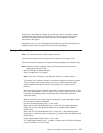2. Do a format without certify.
3. Run a second pass of the Erase Disk selection.
For a newly installed drive, you can ensure that all blocks on the drive are
overwritten with your pattern if you use the following procedure:
1. Format the drive.
2. Check the defect MAP by running the Erase Disk selection.
Note: If you use Format and Certify option, there may be some blocks which
get placed into the grown defect MAP.
3. If there are bad blocks in the defect MAP, record the information presented
and ensure that this information is kept with the drive. This data is used later
when the drive is to be overwritten.
4. Use you drive as you would normally.
5. When the drive is no longer needed and is to be erased, run the same version
of the Erase Disk selection which was used in step 2.
Note: Using the same version of the service aid is only critical if any bad
blocks were found in step 3.
6. Compare the bad blocks which were recorded for the drive in step 3 with
those that now appear in the grown defect MAP.
Note: If there are differences between the saved data and the newly obtained
data, then all sectors on this drive cannot be overwritten. The new bad
blocks are not overwritten.
7. If the bad block list is the same, continue running the service aid to overwrite
the disk with the chosen pattern(s).
This task can be run directly from the AIX command line. See the command
syntax: diag -c -d deviceName -T "format [-s* fmtcert | erase -a {read |
write}] [-F]*
Flag Description
fmtcert Formats and certifies the disk.
erase Overwrites the data on the disk.
* Available in no-console mode only.
-F Force the disk erasure even if all blocks cannot be erased due to errors
accessing the grown defect map.
Note: The Erase Disk option in command line mode uses default values. To
selectively read or write, use the diag command in console mode.
v Certify Hardfile attached to a PCI SCSI RAID Adapter
This selection is used to certify physical disks attached to a PCI SCSI RAID adapter.
Certify reads the entire disk and checks for recovered errors, unrecovered errors,
and reassigned errors. If these errors exceed the threshold values, the user is
prompted to replace the physical disk.
Chapter 6. Introduction to Tasks and Service Aids 99


















